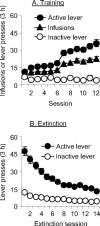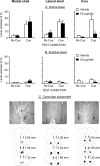Differential effects of blockade of dopamine D1-family receptors in nucleus accumbens core or shell on reinstatement of heroin seeking induced by contextual and discrete cues
- PMID: 18003845
- PMCID: PMC2117350
- DOI: 10.1523/JNEUROSCI.3926-07.2007
Differential effects of blockade of dopamine D1-family receptors in nucleus accumbens core or shell on reinstatement of heroin seeking induced by contextual and discrete cues
Abstract
In humans, exposure to environmental contexts previously associated with heroin intake can provoke drug relapse, but the neuronal mechanisms mediating this relapse are unknown. Using a drug relapse model, we found previously that reexposing rats to heroin-associated contexts, after extinction of drug-reinforced responding in different contexts, reinstates heroin seeking. This effect is attenuated by inhibition of glutamate transmission in the ventral tegmental area and medial accumbens shell, components of the mesolimbic dopamine system. Here, we explored the role of dopamine of the accumbens in context-induced reinstatement by using the D1-family receptor antagonist SCH 23390 [R(+)-7-chloro-8-hydroxy-3-methyl-1-phenyl-2,3,4,5-tetrahydro-1H-3-benzazepine hydrochloride]. Rats were trained to self-administer heroin for 12 d; drug infusions were paired with a discrete tone-light cue. Subsequently, the heroin-reinforced lever pressing was extinguished in the presence of the discrete cue in a context that differed from the drug self-administration context in terms of visual, auditory, tactile, and circadian cues. When tested in the original drug self-administration context, systemic and medial or lateral accumbens shell SCH 23390 injections attenuated context-induced reinstatement of heroin seeking, whereas accumbens core SCH 23390 injections were ineffective. In contrast, core but not lateral or medial shell SCH 23390 injections attenuated discrete-cue-induced reinstatement in a nondrug context after extinction of lever presses without this cue. Results indicate that activation of medial and lateral accumbens shell D1-family dopamine receptors mediate context-induced reinstatement of heroin seeking and provide the first demonstration for a role of lateral shell dopamine in conditioned drug effects. Results also demonstrate novel dissociable roles of accumbens core and shell in context- versus discrete-cue-induced reinstatement of heroin seeking.
Figures





References
-
- Alleweireldt AT, Hobbs RJ, Taylor AR, Neisewander JL. Effects of SCH-23390 infused into the amygdala or adjacent cortex and basal ganglia on cocaine seeking and self-administration in rats. Neuropsychopharmacology. 2006;31:363–374. - PubMed
-
- Anderson SM, Bari AA, Pierce RC. Administration of the D1-like dopamine receptor antagonist SCH-23390 into the medial nucleus accumbens shell attenuates cocaine priming-induced reinstatement of drug-seeking behavior in rats. Psychopharmacology. 2003;168:132–138. - PubMed
-
- Bassareo V, De Luca MA, Di Chiara G. Differential impact of pavlovian drug conditioned stimuli on in vivo dopamine transmission in the rat accumbens shell and core and in the prefrontal cortex. Psychopharmacology. 2007;191:689–703. - PubMed
-
- Basso AM, Kelley AE. Feeding induced by GABA(A) receptor stimulation within the nucleus accumbens shell: regional mapping and characterization of macronutrient and taste preference. Behav Neurosci. 1999;113:324–336. - PubMed
-
- Bischoff S, Heinrich M, Sonntag JM, Krauss J. The D-1 dopamine receptor antagonist SCH 23390 also interacts potently with brain serotonin (5-HT2) receptors. Eur J Pharmacol. 1986;129:367–370. - PubMed
Publication types
MeSH terms
Substances
Grants and funding
LinkOut - more resources
Full Text Sources
Medical
Miscellaneous
